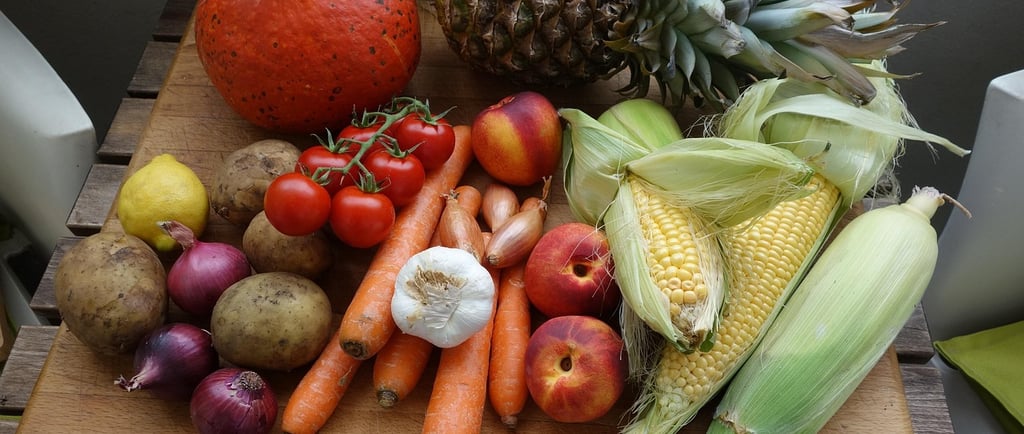Limited time discounts on healthy products!
Maximizing Fiber in Your Diet: A 4-Week Plan to Avoid GI Upset
HEALTHY EATING
11/14/20257 min read


If you’re holding this book, I’m guessing you’re ready to take better care of your digestion, your energy, and your overall health — and you want to do it naturally. Adding more fiber to your diet will help you meet this goal, but you have to do it slowly and sensibly.
--------------------------------------------------------------------------------------------------------------------------------------------------Before we go any further, there are those who should not start a high fiber diet unless they have discussed it with their medical professional. These would be: those being treated for a bowel obstruction, Crohn's disease, ulcerative colitis, or are recovering from recent bowel surgery.
If you are about to have surgery, or start chemotherapy, do not start this diet. Also, a high fiber intake can cause temporary digestive issues like gas, bloating, and cramps, so increase fiber intake gradually, adding the herbal component to reduce the side effects, and drink plenty of fluids.
--------------------------------------------------------------------------------------------------------------------------------------------------
I’m Janine, and for most of my life I’ve been troubled with constipation and gas. Then I discovered healthy eating and herbs. I’ve become fascinated with how plants —from the humble carrot to the fragrant peppermint leaf — can nourish and heal us.
I’ve also learned that the gut is the heart of our health, and our immune system. When your digestion is happy, the rest of your body thanks you with better sleep, a sharper mind, balanced moods, and even healthier skin.
The trouble is, most of us aren’t getting enough fiber. In fact, most adults only eat about half the daily recommended amount of fiber.
That’s like trying to drive across the country with half a tank of gas — you can do it for a while, but eventually the wheels come off (or in our case, the digestion slows down).
Understanding Fiber
You can get fiber by eating fresh fruits, grains, and veggies.
It adds bulk to the stool and aids in moving it through the digestive system, which helps prevent constipation and promotes regularity.
All kinds of fiber play key roles in supporting gut health, reducing the risk of digestive disorders, and maintaining a healthy weight.
The recommended daily maximum intake of fiber varies by age and gender, but generally falls between 25 to 38 grams for adults. However, most individuals do not meet this guideline.
Common sources of fiber include whole grains such as brown rice and quinoa, fruits like bananas and berries, and vegetables such as broccoli and carrots. By gradually incorporating these foods into daily meals, one can significantly improve their fiber consumption (what's know as fibermaxxing), without experiencing gastrointestinal upset.
It is crucial to increase fiber intake slowly, allowing the digestive system to adjust at each level. Understanding the different types of fiber and their distinct benefits sets the foundation for recognizing the importance of fiber in maintaining a healthy diet and digestive health.
The 4-Week Fiber Integration Plan
Integrating fiber into your diet can significantly benefit digestive health, but it is essential to approach this adjustment gradually to prevent gastrointestinal discomfort. This four-week plan helped me to incrementally increase my fiber intake while ensuring a smooth transition to higher-fiber foods.
It’s not about choking down bowls of bran cereal you hate.
Week 1: Low-Fiber Foods 5-18gm of fiber a day
Begin the first week by incorporating low-fiber foods into your daily meals. Focus on foods such as white rice, refined pasta, and skinless fruits and vegetables.
Aim for a no more than 18 grams of fiber daily. Sample meals might include scrambled eggs with a slice of white toast and a banana or a simple chicken salad with lettuce and diced apples. Tracking your intake can be useful; consider using a food diary or a mobile app to monitor your fiber consumption.
Herb pairing: Peppermint tea after lunch or dinner to ease digestion. Remember to drink a glass of water for every 5gm of fiber you add.
Week 2: Incorporate Moderate-Fiber Foods 20-23gm of fiber a day
In the second week, introduce moderate-fiber foods while maintaining the low-fiber options from the previous week. Foods such as whole grain bread, brown rice, and cooked beans can be added.
Aim to consume no more than 23 grams of fiber daily. For example, try oatmeal for breakfast, a turkey sandwich on whole grain bread for lunch, and a side of cooked broccoli at dinner. Continue using your tracking method to observe how your body reacts to these new additions.
Herb pairing- Ginger Tea in the morning to boost digestion.
Week 3: Focus on High-Fiber Foods 25-27gm of fiber per day.
As you enter week three, target higher-fiber foods, including lentils, quinoa, and various fruits and vegetables with skins.
Your goal should be around 27 grams of fiber per day. This can include breakfast smoothies with spinach, berries, and flaxseed, along with a bean chili packed with veggies for dinner. Monitor your body's response and adjust accordingly if you experience any discomfort.
Remember to spread your fiber through out the day, rather than all in one meal.
Herb Pairing- Fennel Tea after dinner to avoid bloating
Week 4: Achieving Fiber Goals 28-30mg of fiber per day
During the final week, optimize your meals to consistently reach 30grams of fiber a day.
Consider creating meals that combine various sources, such as chickpea salads and hearty vegetable soups. As you finalize your plan, keep a log of what works best for you and adjust your fiber sources and quantities based on your individual tolerance levels.
Tracking your progress can aid in sustaining these healthy habits long term. Some people add extra grams of fiber, but if you are just starting out, go slowly to avoid gas and bloating.
The Role of Herbs in Fiber Consumption
Herbs play a significant role in enhancing the consumption of fiber-rich foods while promoting digestive comfort. You probably noticed I suggested a herbal tea for each day during the 4 week journey.
Integrating specific herbs into meals can help mitigate potential gastrointestinal upset often associated with a sudden increase in fiber intake.
Culinary herbs such as ginger, peppermint, and fennel are particularly noted for their beneficial properties that support digestion.
Ginger, for instance, is renowned for its ability to soothe the stomach and alleviate digestive discomfort. This herb can be easily incorporated into a variety of dishes, from stir-fries to smoothies, or even consumed as ginger tea. Its anti-inflammatory properties help reduce gastrointestinal discomfort, making it an excellent companion for those transitioning to a high-fiber diet.
Peppermint is another herb that offers significant digestive benefits. Its menthol content aids in relaxing the muscles of the gastrointestinal tract, which can help relieve symptoms of bloating and gas. Adding fresh peppermint leaves to salads or infusing water with peppermint can enhance both the flavor and digestive benefits of your meals.
Fennel is particularly effective in promoting digestive health due to its carminative properties, which help to reduce gas and bloating. Incorporating fennel seeds into spice blends or using fresh fennel bulbs in salads can significantly enhance fiber-rich dishes. This herb not only adds a distinct flavor but also assists in promoting smoother digestion.
Incorporating these herbs into a high-fiber diet can contribute to overall digestive well-being. Mixing herbs into daily meals or enjoying herbal teas can aid in easing the transition to increased fiber intake while ensuring comfort.
As such, utilizing herbs like ginger, peppermint, and fennel can be a practical approach to enhancing fiber consumption and maintaining digestive health.
Monitoring and Adjusting Your Fiber Intake
As you embark on a journey to increase fiber in your diet, it is essential to monitor how your body responds to these dietary changes. Understanding the relationship between fiber intake and gastrointestinal (GI) health is crucial, as an abrupt increase in fiber can sometimes lead to discomfort, bloating, or other GI upset.
It is important to pay attention to any signs your body may present when adjusting your fiber consumption. If you experience discomfort, you may need to slow and adjust your fiber intake until the discomfort passes.
Begin by gradually increasing fiber in your meals, aiming for a balance that your digestive system can handle. Listen to your body; if you experience significant discomfort, consider scaling back on fiber-rich foods.
Individuals may react differently based on their tolerance levels, so the key is to find a sustainable and comfortable approach that works for you.
Hydration plays a vital role in effective fiber digestion. Adequate fluid intake can help manage potential side effects of increased fiber, such as constipation or bloating. It is advisable to accompany fiber-rich foods with plenty of water, ensuring you remain adequately hydrated.
A general guideline is to aim for at least eight 8-ounce glasses of water daily, but individuals may need more depending on their activity levels and overall diet.
Additionally, maintaining a food diary can be a valuable tool for tracking your fiber intake and its effects on your body.
Documenting the foods you consume, including fiber sources and hydration levels, will help identify patterns and pinpoint specific items that may contribute to discomfort.
Over time, this practice empowers you to make informed decisions about the types and amounts of fiber to include in your diet, ensuring a more positive dietary experience that supports your overall health.
I found the addition of herbs and herbal teas helped me greatly. Try some teas and pick your favorite.
I always suggest that anyone who wants to try an herb, checks out the herb on Herbs At A Glance, to make sure the herbs is safe for you to take and won't interact with any of your conditions or meds.
Disclaimer: All of the content on this website is intended for informational purposes only, and not intended as medical advice. Any action taken based on the content is at your own risk. You should always consult your doctor or medical health professional prior to starting any diet or taking any herb. If you are being treated by a physician and have been prescribed medication, you should seek medical advice before stopping or altering any medication.


Fibermaxxing
Get in touch
Have questions? Comments?
Email me direct ... at reecejanine85@gmail.com
